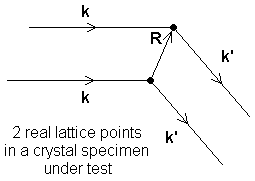6 The Laue Condition
Laue formulated an alternative theorem to the Bragg law for diffraction. This theorem is beneficial because it does not require the assumptions used by Bragg, that reflection is specular and involves parallel planes of atoms.
The derivation is based upon an incident wavevector k being absorbed and re-emitted as an outgoing wavevector k'. The scattering is assumed to be elastic, that is ½k½ = ½k'½.

Figure 15: Elastic scattering in terms of wavevectors

